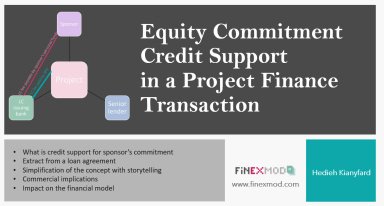
Originally published: 06/12/2021 13:11
Publication number: ELQ-18215-1
View all versions & Certificate
Publication number: ELQ-18215-1
View all versions & Certificate

Credit Support for Sponsors’ Equity: What is it and how to model it (Including a complete project finance model)
This Excel based template and manual discusses lenders requirement for credit support from sponsors to guarantee their equity
project financeproject finance modelcredit supportequityloan agreementletter of creditundrawn equity
Description
Because there is a possibility for investors not to commit all their equity up-front at financial close, lenders require credit support from sponsors to guarantee their obligations (Maximum sponsor equity commitment).
This manual and financial model include:
✔️What is credit support for sponsor’s equity commitment
✔️Extract from a loan agreement
✔️Simplification of the concept with storytelling
✔️Commercial implications
✔️a complete financial model including calculation of fees related to letter of credit for supporting sponsors undrawn equity commitment
the Excel template is a simple but complete project finance model.
The Excel template contains the following worksheets:
✔️QA: A worksheet aiming to keep track of questions and answers on the financial model.
✔️Inputs: Contains the model inputs structure in form of scenario analysis.
✔️Scenario Output: A tool to keep track of scenarios.
✔️Summary: Summary key inputs & Outputs like Summary Sources and Uses of Funds Cover ratios, and Shareholder return.
✔️Guide: Contains the color codes used in the model, and model structure.
✔️TableOfContent: List all worksheets in the model with links.
✔️Mastersheet: You can use it to create a new worksheet.
✔️Time: Calculation of the different timing flags and counters, used as time reference throughout the model.
✔️CapEx: Calculation of construction cost breakdown
✔️Financing: Includes:
- Calculation of sources and uses of funds during the construction period.
- Calculation of disbursement profiles
- Debt drawdowns and repayment profiles
✔️Rev&OpEx: Includes :
- Revenues of the project
- Opex calculation
- Account receivables
- Account Payables
✔️Tax: Includes calculation of:
- Depreciation
- Corporate Income tax payment
✔️Return&Ratios: Calculation of debt and equity ratios, including the debt service coverage ratio (DSCR), and equity IRR
✔️IFS: Cashflow, balance sheet and income statement on periodic basis using time inputs from "Inputs" sheet.
✔️Checks: contains model error and integrity checks
To avoid and cure the circularity in the sources and uses of funds, the model uses a copy and paste code. You need to run the code when you change construction costs and financing terms. It is not the most optimum way of resolving the issue but it's better than having an iterative model. For more on this topic check: edbodmer.com
You can use the manual and template to include the different disbursement options and flexibility in drawdowns into your own project finance models ; test the impact of including the fee related to the letter credit on total project cost and equity IRR or use it for educational purposes.
You can read my blog post on this topic from below:
https://www.finexmod.com/credit-support-for-sponsors-equity-what-is-it-and-how-to-model-it/
Because there is a possibility for investors not to commit all their equity up-front at financial close, lenders require credit support from sponsors to guarantee their obligations (Maximum sponsor equity commitment).
This manual and financial model include:
✔️What is credit support for sponsor’s equity commitment
✔️Extract from a loan agreement
✔️Simplification of the concept with storytelling
✔️Commercial implications
✔️a complete financial model including calculation of fees related to letter of credit for supporting sponsors undrawn equity commitment
the Excel template is a simple but complete project finance model.
The Excel template contains the following worksheets:
✔️QA: A worksheet aiming to keep track of questions and answers on the financial model.
✔️Inputs: Contains the model inputs structure in form of scenario analysis.
✔️Scenario Output: A tool to keep track of scenarios.
✔️Summary: Summary key inputs & Outputs like Summary Sources and Uses of Funds Cover ratios, and Shareholder return.
✔️Guide: Contains the color codes used in the model, and model structure.
✔️TableOfContent: List all worksheets in the model with links.
✔️Mastersheet: You can use it to create a new worksheet.
✔️Time: Calculation of the different timing flags and counters, used as time reference throughout the model.
✔️CapEx: Calculation of construction cost breakdown
✔️Financing: Includes:
- Calculation of sources and uses of funds during the construction period.
- Calculation of disbursement profiles
- Debt drawdowns and repayment profiles
✔️Rev&OpEx: Includes :
- Revenues of the project
- Opex calculation
- Account receivables
- Account Payables
✔️Tax: Includes calculation of:
- Depreciation
- Corporate Income tax payment
✔️Return&Ratios: Calculation of debt and equity ratios, including the debt service coverage ratio (DSCR), and equity IRR
✔️IFS: Cashflow, balance sheet and income statement on periodic basis using time inputs from "Inputs" sheet.
✔️Checks: contains model error and integrity checks
To avoid and cure the circularity in the sources and uses of funds, the model uses a copy and paste code. You need to run the code when you change construction costs and financing terms. It is not the most optimum way of resolving the issue but it's better than having an iterative model. For more on this topic check: edbodmer.com
You can use the manual and template to include the different disbursement options and flexibility in drawdowns into your own project finance models ; test the impact of including the fee related to the letter credit on total project cost and equity IRR or use it for educational purposes.
You can read my blog post on this topic from below:
https://www.finexmod.com/credit-support-for-sponsors-equity-what-is-it-and-how-to-model-it/
This Best Practice includes
Including a video tutorial and Excel template







